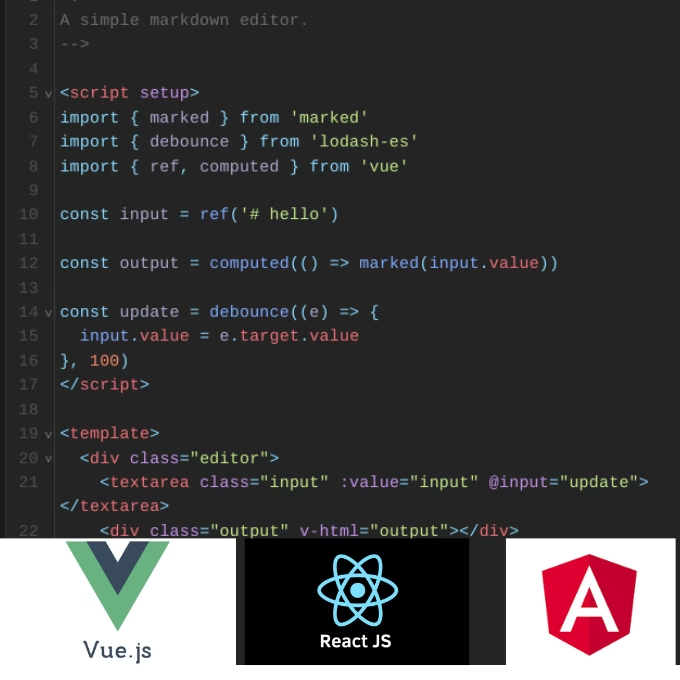Contents
The JavaScript ecosystem is constantly evolving, with it, the landscape of JavaScript frameworks. React, Vue, and Angular have emerged as the top three contenders, each with unique strengths and weaknesses.
What are the pros and cons of each framework;
How to create SEO strategies for single-page applications (SPAs), and
What about their performance;
Understanding the Big Three
React
Developed by Facebook, React is a component-based library for building user interfaces. It focuses on creating reusable UI components, making it highly flexible and adaptable to various project scales.
React Pros:
- Component-Based Architecture: Encourages modularity and reusability.
- Virtual DOM: Optimizes performance by efficiently updating the DOM.
- Large Community and Ecosystem: Extensive support, libraries, and tools.
- Declarative Programming: Simplifies UI development by describing the desired state.
React Cons:
- Steeper Learning Curve: Requires understanding of concepts like JSX and state management.
- Boilerplate Code: This can be verbose, especially for larger applications.
Vue
Vue is a progressive framework that can be used incrementally or as a full-featured framework. It strikes a balance between simplicity and power, making it a popular choice for developers.
Vue Pros:
- Gentle Learning Curve: Easy to pick up for beginners.
- Versatile: Can be used for small to large-scale applications.
- High Performance: Efficient rendering and update mechanisms.
- Clear Documentation and Community: Strong community support and well-documented resources.
Vue Cons:
- Smaller Ecosystem: Compared to React and Angular, Vue has a smaller ecosystem of libraries and tools.
- Potential for Complexity: As applications grow, managing state and complexity can become challenging.
Angular
Developed by Google, Angular is a comprehensive framework for building complex web applications. It provides a full suite of tools and features, including dependency injection, routing, and form validation.
Angular Pros:
- Full-Featured Framework: Offers a complete solution for building large-scale applications.
- Strong Community and Support: Backed by Google and has a large community.
- TypeScript Integration: Enhances code quality and maintainability.
- Performance Optimization: Built-in performance optimization techniques.
Angular Cons:
- Steep Learning Curve: Requires a deep understanding of Angular concepts and TypeScript.
- Opinionated Framework: This can be restrictive in terms of project structure and development approach.
SEO Considerations for SPAs
SPAs, built heavily on JavaScript, can pose challenges for search engine crawlers. To ensure your SPAs are search-engine friendly, consider the following strategies:
Server-Side Rendering (SSR):
- Render initial HTML on the server, making it easier for search engines to index content.
- Frameworks like Next.js (React) and Nuxt.js (Vue) provide built-in SSR support.
Dynamic Rendering:
- Serve different HTML content to search engines and users.
- Frameworks like Gatsby (React) and Gridsome (Vue) offer this functionality.
JavaScript SEO Best Practices:
- Meaningful HTML Structure: Use semantic HTML elements and avoid over-reliance on JavaScript for content rendering.
- Unique Page Titles and Meta Descriptions: Provide descriptive titles and meta descriptions for each page.
- Internal Linking: Create a clear internal linking structure to help search engines discover content.
- Mobile-Friendliness: Optimize your SPA for mobile devices.
Performance and SEO Implications
JavaScript frameworks can significantly impact your website’s performance and SEO. Here are some tips to optimize your SPAs:
- Code Splitting: Break down large JavaScript bundles into smaller chunks to improve load times.
- Tree Shaking: Eliminate unused code to reduce bundle size.
- Minification and Compression: Reduce file size by removing unnecessary characters and compressing files.
- Lazy Loading: Load JavaScript resources only when needed to improve initial page load time.
- Leverage Browser Caching: Set appropriate cache headers to reduce server load.
- Optimize Images: Compress images and use appropriate formats.
- Minimize HTTP Requests: Combine and minify CSS and JavaScript files.
- Prioritize Critical Rendering Path: Optimize the critical rendering path to improve initial page load time.
The choice of JavaScript framework depends on your project’s specific needs, team expertise, and long-term goals. Read and understand the pros and cons of React, Vue, and Angular, so you can make informed decisions to build high-performance, scalable, and SEO-friendly web applications.

